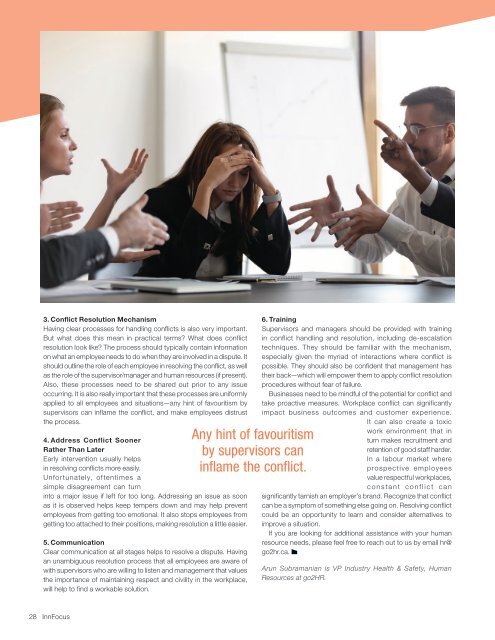InnFocus Spring 2023
InnFocus magazine for hoteliers in British Columbia
InnFocus magazine for hoteliers in British Columbia
Create successful ePaper yourself
Turn your PDF publications into a flip-book with our unique Google optimized e-Paper software.
3. Conflict Resolution Mechanism<br />
Having clear processes for handling conflicts is also very important.<br />
But what does this mean in practical terms? What does conflict<br />
resolution look like? The process should typically contain information<br />
on what an employee needs to do when they are involved in a dispute. It<br />
should outline the role of each employee in resolving the conflict, as well<br />
as the role of the supervisor/manager and human resources (if present).<br />
Also, these processes need to be shared out prior to any issue<br />
occurring. It is also really important that these processes are uniformly<br />
applied to all employees and situations—any hint of favouritism by<br />
supervisors can inflame the conflict, and make employees distrust<br />
the process.<br />
4. Address Conflict Sooner<br />
Rather Than Later<br />
Early intervention usually helps<br />
in resolving conflicts more easily.<br />
Unfortunately, oftentimes a<br />
simple disagreement can turn<br />
into a major issue if left for too long. Addressing an issue as soon<br />
as it is observed helps keep tempers down and may help prevent<br />
employees from getting too emotional. It also stops employees from<br />
getting too attached to their positions, making resolution a little easier.<br />
5. Communication<br />
Clear communication at all stages helps to resolve a dispute. Having<br />
an unambiguous resolution process that all employees are aware of<br />
with supervisors who are willing to listen and management that values<br />
the importance of maintaining respect and civility in the workplace,<br />
will help to find a workable solution.<br />
Any hint of favouritism<br />
by supervisors can<br />
inflame the conflict.<br />
6. Training<br />
Supervisors and managers should be provided with training<br />
in conflict handling and resolution, including de-escalation<br />
techniques. They should be familiar with the mechanism,<br />
especially given the myriad of interactions where conflict is<br />
possible. They should also be confident that management has<br />
their back—which will empower them to apply conflict resolution<br />
procedures without fear of failure.<br />
Businesses need to be mindful of the potential for conflict and<br />
take proactive measures. Workplace conflict can significantly<br />
impact business outcomes and customer experience.<br />
It can also create a toxic<br />
work environment that in<br />
turn makes recruitment and<br />
retention of good staff harder.<br />
In a labour market where<br />
prospective employees<br />
value respectful workplaces,<br />
constant conflict can<br />
significantly tarnish an employer’s brand. Recognize that conflict<br />
can be a symptom of something else going on. Resolving conflict<br />
could be an opportunity to learn and consider alternatives to<br />
improve a situation.<br />
If you are looking for additional assistance with your human<br />
resource needs, please feel free to reach out to us by email hr@<br />
go2hr.ca.<br />
Arun Subramanian is VP Industry Health & Safety, Human<br />
Resources at go2HR.<br />
28 <strong>InnFocus</strong>
















